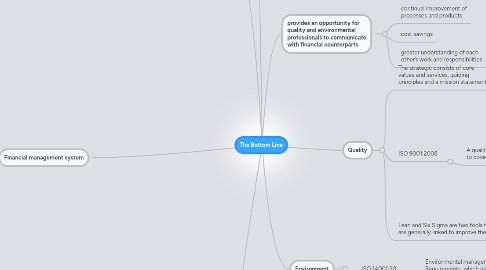
1. The implementation of (QMS) enhances customer and employee satisfaction, and improves awareness of customer requirements
2. business management systems behave like independent silos
2.1. *less-than-optimal operations
2.2. *excessive costs
2.3. *dissatisfied customers
2.4. *unhappy investors
3. Financial management system
3.1. Investment management
3.1.1. Tools used to make good decisions concerning the costs and benefits of projects
3.1.1.1. Payback
3.1.1.2. Net present value
3.1.1.3. Economic value added
3.1.1.4. Review of the variances associated with current budgets.
3.1.1.5. Statistical forecasting
3.1.1.6. The breakeven point
3.2. Statement of cash flow
3.2.1. describes day-to-day business operations
3.2.1.1. operations
3.2.1.2. investments
3.2.1.3. financing
3.3. P&L statement
3.3.1. It consists of income (revenues, earnings and investments) and expenses (cost of goods sold, or COGS, operating expenses, provision expense, capital expense and income tax).
3.4. Balance sheet
3.4.1. the financial health and liquidity of the business over time
3.5. General ledger
3.5.1. Is where all accounting transactions are recorded. It is the data source for most of the basic financial statements
3.6. System of internal control
3.6.1. Aid in achieving an organization’s goals and objectives, assist in reliable financial reporting and compliance, lead the organization through its day-to-day operations and provide rules or guidelines for activities that identify and mitigate risks.
3.6.2. objectives:
3.6.2.1. 1. Effectiveness and efficiency of operations.
3.6.2.2. 2. Reliability of financial reporting.
3.6.2.3. 3. Compliance with laws and regulations.
3.6.3. COSO 5 interrelated components:
3.6.3.1. 1. The control environment.
3.6.3.2. 2. Information and communication.
3.6.3.3. 3. Risk assessment.
3.6.3.4. 4. Monitoring.
3.6.3.5. 5. Control activities.
3.6.3.6. ISO 9001 and ISO 14001 provide support
3.6.3.7. for a compliant system of internal
3.6.3.8. control
3.7. Statement of cash flow
4. Be supportive
4.1. The central theme of quality and environmental management is continual improvement,
4.2. QMS and EMS support provides financial management with a better understanding of current operations.
4.3. An effective QMS and EMS help top management and the board of directors identify business risks, control those risks and prevent major surprises. These management systems provide added resources, especially for internal auditing, reducing the cost of compliance and improving corporate governance by connecting management systems
5. provides an opportunity for quality and environmental professionals to communicate with financial counterparts
5.1. continual improvement of processes and products
5.2. cost savings
5.3. greater understanding of each other’s work and responsibilities
6. Quality
6.1. The strategic consists of core values and services, guiding principles and a mission statement.
6.2. ISO 9001:2008
6.2.1. A quality manual should be constructed to cover the eight basic clauses
6.2.1.1. The first 3 clauses
6.2.1.1.1. cover the scope of the standard, references, terms and definitions
6.2.1.2. Clause 4
6.2.1.2.1. defines the process approach and documentation requirements
6.2.1.3. Clause five
6.2.1.3.1. management responsibility
6.2.1.4. Clause six
6.2.1.4.1. resource management
6.2.1.5. Clause seven
6.2.1.5.1. product and service realization
6.2.1.6. Clause eight
6.2.1.6.1. measurement, analysis and improvement
6.3. Lean and Six Sigma are two tools that are generally linked to improve the QMS.
7. Environment
7.1. ISO 14001:20
7.1.1. Environmental management systems— Requirements, which defines a structure similar to ISO 9001:2008.
